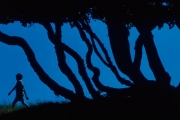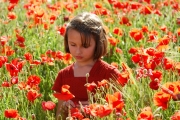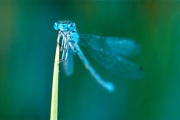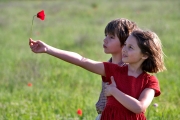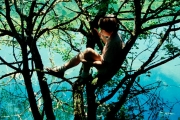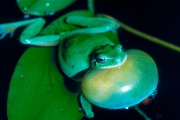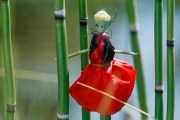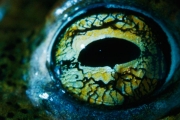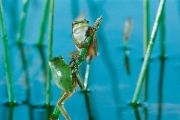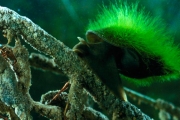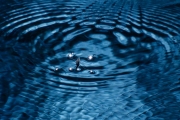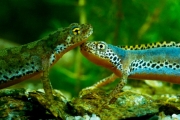Synopsis
A deserted pond, two lonely children fall under the spell of this wild place that, little by little, draws them closer to each other and gives them the strength to cope with life. Seen through their eyes, and through their imaginations, the pond becomes a secret kingdom, both marvellous and frightening, thronging with creatures born from dreams or nightmares. The children experience an initiation, brief and intense, from which they will emerge transformed.
Cast & Crew
Director : Claude Nuridsany and Marie Perennou
Screenwriter : Claude Nuridsany and Marie Perennou
Starring : Simon Delagnes, Lindsey Henocque and Jean-Claude Ayrinhac
Schedule & Presentation
![]() Presentation by and discussion with directors Claude Nuridsany and Marie Perennou
Presentation by and discussion with directors Claude Nuridsany and Marie Perennou
Saturday, March 31 – 11:00 a.m at the Byrd Theater ~ ![]() 1h21 ~ General Audience
1h21 ~ General Audience
More informations
Choose a picture to see the filmography (source : IMDB)
The Field Of Enchantment is a natural fairy tale, a fiction dedicated to nature and childhood. The pond – this place the children have chosen as a sort of virgin paradise, a refuge far from the world of grownups – becomes a magic mirror through which they discover unknown beings that will return them anew to their own lives. The animals and miniature landscapes explored on the banks of the pond will be seen through the children’s eyes. Everything filmed will of course reflect events from the natural world, but transformed by framing, light, cinematography, sound… Thus the animals will become real characters – fairies, ogres, dragons, dream beasts – sometimes comical, sometimes nightmarish.
Our aim is to reveal to the viewer, child and adult alike, that the greatest wonders, the most profound transfiguration, can be discovered in the heart of the ordinary. A nondescript pond in the countryside can, if we look carefully enough, become an ocean inhabited by extraordinary creatures.
We will use the most powerful filming equipment available (endoscopes, boroscopes, microscopes, high speed cameras, and motion-control optical technology developed specifically for the film) to enhance our view of the living world that surrounds us and convey a poetic, enchanted vision of nature.
Claude NURIDSANY & Marie PERENNOU
Since Microcosmos, your work has been celebrated worldwide, but we know very little about you. How and why did you start working together?
Marie: We met at the Cinémathèque when we were in our twenties. We shared a passion for cinema but realized early on that we also shared a passion for nature, art, music, photography and literature. We have been working together for about thirty years, beginning with photography and books.
Claude: We quickly started working on articles and photographs dedicated to nature. Convinced that communicating with nature is part of being human, we wanted to share our aesthetic passion. The issue for us was not to talk about particular species, even though that can be fascinating, but about animals almost as small divinities, so strange and so enigmatic. These creatures constituted a sort of mystery that intrigued us. Little by little we defined a sort of mythology, spontaneously built up from our examination of the relationship with nature, not only with animals but also plants, whose aesthetic quality is very powerful.
Marie: We started with photography, and first conceived books about insects, then a whole body of work about plants, buds and wild fruits, seen as small sculptures, natural works of art. It took us years to complete this, working at the same time on other activities like magazine features. It was not easy to establish ourselves with this particular fragmentary vision but still, we were able to make a living from this profession which is not really one. It was a matter of translating this deeply lived, deeply rooted need to link aesthetics and meaning.
Do you think you could have done this job without each other? What does each bring to the other?
Marie: There is a never-ending back and forth between what one brings to the other. We have followed our course together all our life, even though we are very different. We live and work together but are both free. We have built our vision of the world by talking a lot. I have the feeling I have found my niche, and I do not know what I would have become if I had not met Claude.
Claude: I could never have done on my own what we did together. Each of us is somehow responsible for the other’s destiny. Right from the beginning we realized that to express our fascination for nature, we needed something very different from the traditional ‘naturalist’ approach.
Marie: We were not at all interested in showing animal life, of which we only know parts. We did not want to make educational documentaries which are often misleading in relation to a reality that scientists and philosophers are only starting to clarify now. We wanted a much freer way of expressing ourselves, one that would be an invitation to reverie. We wanted to remain in the unfathomable mystery of the other, this creature which is certainly much richer than we believe, and to respect its being.
You function in perfect symbiosis. Your films appear as the work of a single entity. How do you split the work?
Claude: We do not split the work according to each other’s particular skills; it is more of a continuous exchange, building up to something complete. Neither of us has ever had to give up on something he or she was keen on. We are alike enough to recognize what is essential to the other, and fully bloom within the entirety that we built together.
Marie: For my part, I see myself in all the work we have done, even if working together is very particular and not always simple. In our endeavour to reach a goal, we have some things in common, others less so, but complementary.
How would you define the essence of your work?
Claude: Very early on we realized that what really interested us most in nature was the relationship with the imaginary. Man brings his own interpretation to his perception of it, like when as children we play “Let’s pretend”. Since Microcosmos we have filmed animals as true classical heroes. We suggest a vision to the spectator, hoping his imagination will grasp it so it will feel as if he is the only one to look at it in this way. Of course we have to light, frame and direct to invite the audience to look not at an ant dragging a blade of grass on a carpet of moss, but at a character in the virgin forest. Thanks to a transposition of scale, we make the grass appear as a virgin forest. Beyond this call to the imagination and the exterior, the relationship with nature that we suggest to the spectator is also introspective and brings him back to the depths of his being.
So, The Field of Enchantment is a sort of culmination of your work…
Marie: Exactly. The Field of Enchantment unites two tendencies we have always had in us: the world of childhood and the feeling of nature.
Claude: In The Field of Enchantment, nature helps the child to discover, define and refocus himself. Faced with an over-organized adult world, it allows him to find his roots again. Nature is reassuring because animals know how to live while children do not understand the rules of a highly elaborated adult world. We are not born in harmony with the human world. You have to understand its codes and accept them to be able to enter it. Marie: Nature helps children to find their place in the world. Things are simpler there. By observing nature we learn rules. The child is in the position of the privileged observer. He cannot be the victim of the violence he witnesses. In a way he can act as a god who has the power to save or not to save the ant that is about to drown. The fact that he is an observer gives him a protective distance and a crucial knowledge.
How was this project born?
Claude: Once we complete a movie, we do not rush into the next one. We might even ask ourselves whether we will go on making films. We only launch ourselves into a new project if it becomes a necessity.
Marie: This project started, paradoxically, with a slight disengagement from animals. We weren’t wildly enthusiastic about a movie whose only subject would be nature and animals – one we had already explored. On the other hand, the thought of connecting that world to the world of childhood excited us.
Claude: The pond and the childhood came at the same time. Mainly, because we remained children. We are animals whose metamorphosis is imperfect. At the risk of sounding silly, we are lucky to have kept our sense of wonder.
Marie: We are still children in the sense that we can be amazed at certain things, perhaps almost everything. This wonder at the world around us gives a sort of freshness of gaze and a critical insight into the rules of the adult world.
What do you think we lose by becoming adult?
Marie: We have often noticed that adults are busy with more important things and no longer notice little things. Nonetheless, these little things are often essential and losing sight of them can take you away from what you really are and turn you to other, often futile, occupations. Claude and I feel that we have kept this perception of the small things that enrich our daily lives. They are a driving force for us, almost a reason for living.
Claude: However, growing up does not explain everything. I remember very well having known children who were already little adults, with adult ambitions like owning a big car or that sort of nonsense. Fortunately it is very rare. Conversely, some adults retain this part of childhood, of wonder.
Is it also to allow them to find a way towards this aspect of childhood that you have made this film?
Claude: That is right; we hope that our films can help adults to reconnect with the intimate part of their childhood. We understand very well that, because of their activities, they may have forgotten the way a bit, but if you suggest the direction, many find it again right away. Like the scent of the Proust’s madeleine, it takes very little to open the doors of the past and those of childhood. Someone who has not watched an ant for forty years can suddenly experience the memory of hours spent looking at lines of ants at his grandmother’s flooding back. We are sensitive to mental images. That is why we think that cinema, which appears to be an objective recording of what is happening, is anything but objective. These are mental images. Even with nature and animals, the frame, the choice of light according to the time of day, the work on sound and the direction, all strive towards re-creation.
In view of your path in life, the little boy and the little girl in the film could remind us of you both. Which part of your own childhood did you instilled in them?
Marie: Of course there is a relation between these two children and the children we were. But I was not lucky enough to experience the wonder of a childhood love. Claude and I were already adults when we met. But one of our first walks together was by a pond and we discovered we both loved it. Up until then I had never met anyone who was not bored by that sort of thing.
Claude: Rummaging through aquatic plants on the banks of a pond and smelling the sludge side by side with someone you love seemed incredible to me, especially because my entire childhood was spent in loneliness as regards to my relationship to nature. It was a happy relationship but there was emptiness because I was alone. The film is a bit like a fairy tale, an ideal story we have invented around the universal theme of childhood love. The characters of the little girl and the little boy are doubtless a mixture of us. There are some of us in each character.
Do you choose the animals you film the same way you would chose actors?
Marie: It is a sort of casting. We know them all and what we can hope from each one according to its potential. What is difficult is to shoot enough to get what we hoped for, without being content just with what they give us easily. Claude: The emotional perception of the creatures we have chosen is essential. As with the characters of a fiction, some recall fairies, others dragons, toys or monsters. It is a bestiary close to childhood, linking the wonderful and the ugly. The film alternates both and that is how we conceived it, through a long process at first. We proceed as we would in a musical composition, playing on contrasts of characters and emotions. We laugh, we question ourselves, we get scared. Human beings do not function through objectivity – except in the field of science. In an entertainment we tend to want a restitution based on feelings. We try to convey and help recall the feelings at the time of discovery or encounters with these creatures. This is the case, for example, in the very short sequence where tadpoles seem to be running in all directions like children in a playground. Each and every one of us associates these displays with something of our own.
How long did it take to make this film and how did you do it?
Claude: It took four years, for the preparation, the shooting and the editing. The writing is a fascinating phase. The shooting is the most laborious. You have to be philosophical. Since we started making films, we have come to realize that we begin each sequence at the best time, having just tracked down the animal. And yet, even before the first shot is done we start thinking it will never work. But we continue anyway. Sometimes we shoot for four days and realize that we have nothing we can use. Then all of a sudden, a miracle happens!
What is the ratio between what you shot and what we see in the film?
Marie: There are very few shots we did not use. We stick very closely to our shooting plan.
Claude: We can go back to these shooting plans, according to the season, the light or the arrival of an interesting new creature – a dragonfly that lands on a flexible leaf. Then we drop everything else to focus on it. We only film with a purpose, never just to be shooting. It is very close to fiction – only our actors are absolutely untameable.
Do you encounter remarkable “actors”?
Claude: It is impressive how much each animal has its own individuality. They are real characters and not at all interchangeable. When we come across one with its own interesting way of doing things, we insist on trying to get as much as it can give us. Even animals as basic as diving beetle larvae, with their huge mandibles, hooked beneath the water, can be clearly distinguished from one another. It is very striking during their battles. So to find this and film it you have to have some kind of almost crazy obstinacy. First you think it is impossible but you have to persist.
This film is very particular in the way it connects the world of our scale to the less visible world of the pond. How were you able to overcome this technical challenge?
Claude: We shot over a period of three and a half years during spring and summer. We recreated a pond in a giant tank for newts and ‘bottom-dwelling’ creatures. To get murky waters, sludge, suspended particles capturing the light, all this requires time. We filmed in 35mm and used a whole array of cameras and remote controlled shooting devices, as well as endoscopic cameras, in order to obtain the shoots we were looking for. Marie: We shot each day from 9.30am to 7pm with the help of an assistant. We could not have obtained images of such quality if we had not shot certain scenes in a tank. And yes, this film connects two worlds with two very different scales, but we have combined them in a number of more dreamlike visions, like when the little girl enters the poppy or when the two children stroll underwater in what we call “the sequence of the mystery of the deep”.
What about the specific scenes with the children?
Claude: We filmed separately over eight weeks with a director of photography because directing, supervising the image and the children was just too much for us! So we found ourselves surrounded by a crew of twenty-five, which is unusual for our way of working. We asked the producers for a crew reduced to the absolute minimum, in particular to avoid disturbing the children – Simon Delagnes and Lindsey Henocque – who had never acted before. It was a challenge for them.
How did you find this ideal pond?
Marie: The world of ponds has always fascinated us. We used IGN (Institut National de Geographie) maps and visited all of them in the surrounding area. We looked locally first but were ready to go further afield. However, we did not find the pond in the film ourselves. Pascal Arnaud, an environmental warden who has become a friend, found it on the Larzac. We fell in love with it! It was ideal because every species of frog and toad can be found there. The place contained everything, birds as well, an incredible richness that offered us both location and animals. We had to act quickly though because it dries up with the heat in summer.
You approach nature playfully. Where did you get these makeshift objects built by the children?
Claude: I have childhood memories of objects built with bits and bobs found in nature. For years I thought that if I had the time I would use acorns to make characters. To have the time to make small objects with natural elements is my idea of paradise! Of course I have never had the time. Besides, it is playful and truly beautiful at the same time. You can find a simple curved stick that can become a magnificent figurehead. Children have that sense: they know perfectly what to gather and how to transform it.
The sound is also essential. How did you define it?
Marie: It is still the result of childhood plunged into the imaginary. Jean Goudier suggested car horns, a little traffic jam for the scene with water spiders. For the very calm shot with walnut shells as little boats, Jean suggested the sound of an English navy whistle and the creaking of a ship’s skeleton. A child looks at a walnut shell and is already aboard a galleon crossing the ocean.
Claude: The correct balance of these elements is crucial. You have to know where to stop, or else you go too far into the descriptive and there is no room left for the imagination. They’re really elements whispered in the ear of the spectator, who taps into the sound without really noticing. From this sound he constructs some kind of mental scene.
You turned once more to Bruno Coulais for the music…
Marie: This really was a film for him – he is a poet. We finished the shoot and before beginning the editing we showed him all the rushes. He started writing the music as we were editing the film.
Claude: He has a spontaneous connection with childhood; he taps into it directly and effortlessly. We were very fortunate to run into Bruno early on in our work. Bruno is careful that the music does not burst into the film. It often appears combined. Sound and music had to be created in perfect harmony. Bruno was able to make the music suggestive through an ethereal, almost translucent, orchestration.
How did you choose Denis Podalydès for the voice over?
Marie: Claude wrote the text and we wondered for a very long time who could be the voice. We did some trials and made a model. Claude’s voice has a good timbre but it was not enough, we needed a certain tone. It was a job for an actor. We quickly thought of Denis because of the feelings he can convey without overemphasizing.
Claude: I could not distance myself enough to be able to work objectively. Only professional actors can do that. Working with Denis’ voice put me at ease somehow. We chose him for his talent but also because his voice is somewhat distinctive. Even thought it is a man’s voice, it has a youthful quality to it. He says so himself. His timbre was the perfect link between the child that we see and the adult who recalls.
What do you hope to bring to the audience with this film?
Claude: Above all, we hope to convey something intimate. Our work consists of not betraying this feeling of intimacy. We also bank on being able to share it. We do not choose this feeling of nature, of childhood, of solitude felt then shared – by chance. We would like all this to trigger in the imagination, the memory and experience of the audience – something both pleasurable and fragile.
Marie: We feel this world very deeply and hope others can find themselves in it. We want to bring pleasure, happiness, and also surprise: the surprise of discovering or rediscovering a path that leads to the depths of oneself.



